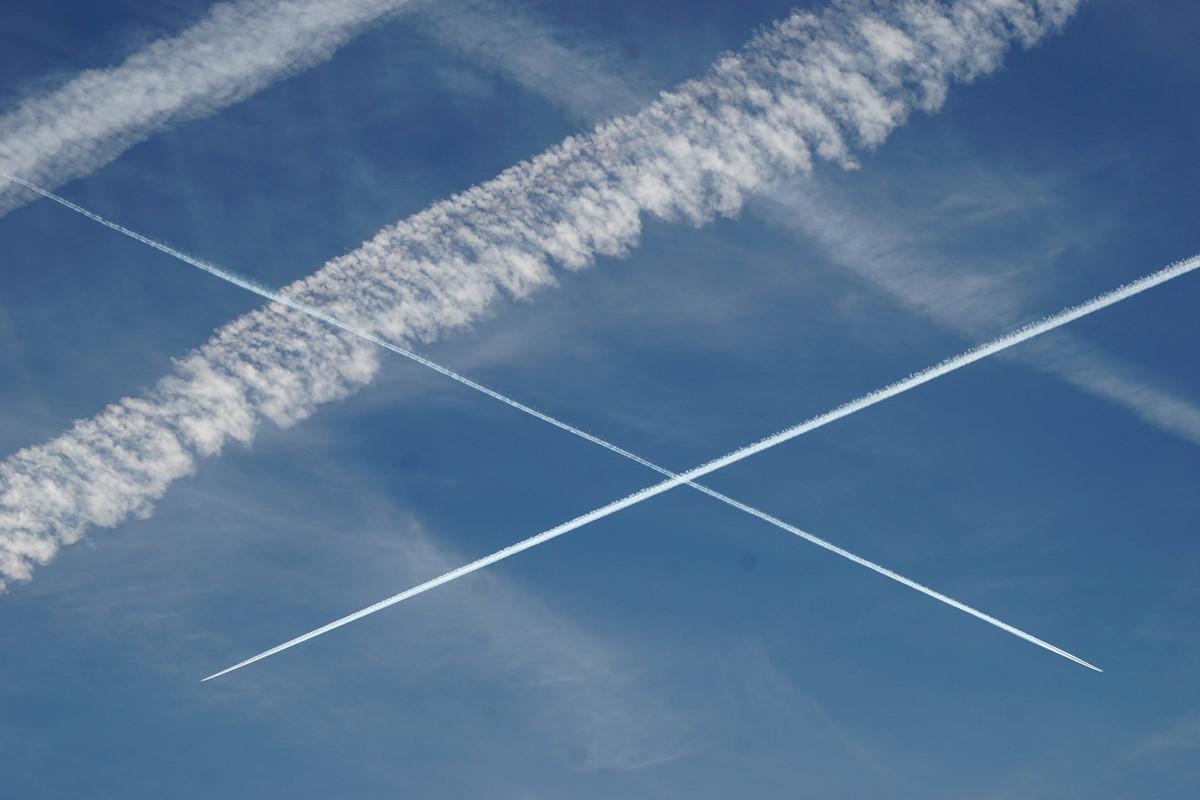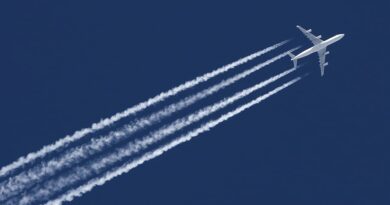A brief explainer on the chemtrails conspiracy theory

The hot weather is seeing the conspiracy that planes are pumping poison into the sky take off again – but is there any truth in the theory?
If you’re into your conspiracy theories – or are just a massive Lana stan – it’s likely you’ll have heard of chemtrails before.
Those white lines that trail behind planes in the sky are actually called contrails, and they’re essentially streaks of water vapour and a minute amount of soot particles, crystallising into ice at high altitudes and visible from down below. But in slightly more esoteric circles, contrails aren’t the only thing emitted by planes. Enter chemtrails. Conspiracists think that while contrails might exist, some of the white streaks last too long and are too large to be just water vapour – instead, they believe that they must consist of other chemicals. Many supporters of the theory argue that these ‘other chemicals’ are purposefully and nefariously sprayed into the atmosphere by the government for myriad reasons.
This theory has been circling around the internet for decades. In the late 90s, internet forums started to propagate the idea that the US government was spraying citizens with chemicals, leading to US aviation and environmental agencies desperately trying to ground the discourse. Since then, it’s flown across the world, famously reaching the UK government in 2005 when David Drew MP asked about the effects of chemtrails, a bit like that time Brass Eye got politicians to talk about a made-up drug called Cake. The theory has never really gone away, instead just waxing and waning in popularity.
Jason Pearce, moderator of Chemtrails UK – a Facebook community where thousands of devoted followers incessantly photograph trails from Sunderland to Southampton – explains further. “The chemtrails theory is based on various different ideas and beliefs that the white lines being sprayed by aircraft that happen all year round now are being done intentionally,” says Pearce. “It’s not just water vapour, but a concoction of different chemical pollutants and gases that are being trapped in the higher altitudes of our atmosphere.”
This base view, it seems, is pretty much where the consensus ends. First, there’s the question of the planes; some believe only military jets are doing us dirty, others believe commercial airlines are in on it too. Then there are the chemicals – what exactly are we being sprayed with? Popular suggestions include barium, strontium and sulphur, or, if you’re feeling wild, vaccines. Basically, anything but ice crystals.
Why do these people think we are being sprayed? “There are many different ideas and conclusions as to why they are being sprayed,” Pearce says. These include “deliberately blocking the sun”, increasing “mobile phone frequency”, some form of “mind control” or “hiding the notorious planet Nibiru” which, he says, has a “collision date that’s always changing”. Notice some sarcasm? Well, even as the figurehead of the group, Pearce is actually surprisingly moderate in his views, thinking that “these wackier ideas could actually have been planted in the population’s minds to stop any debate and discussion about the topic”, making us think that anyone who talks about chemtrails is a “conspiracy loon who should have a tin foil hat on their head”.
Of course, a lot of the people in the group, err, are a bit loony. While Pearce validly draws attention to the negative effects of aviation on the environment and the complex nature of pollution, many other chemtrails-truthers spout climate-denier bullshit. The feverish echo chamber also leads to a psychosomatic discussion of symptoms – from headaches, to altered periods, to “the dog’s farts” smelling weird – all supposedly caused by chemtrails.
As with the symptoms, it’s the subjectivity and invisibility of the theory itself that makes it so infectious. While science can prove the composition of contrails, it can’t do so in an easy, neat way, leading to faux science. Like most of the most successful conspiracy theories, it’s based on an unseen force as mysterious and microscopic as Covid-19 particles or 5G waves. Equally, though, it’s easily ‘accessible’: just look up at the sky, and you can see the ‘evidence’ for yourself.
Why is the theory taking off again right now? Last month, chemtrails was trending on Twitter, propelling heated discussion and forcing a load of news outlets to once again denounce the theory. “I do think it’s had a bit of a renaissance this year,” says Sarah Turnnidge, a fact-checker and journalist at Full Fact. The site has been pumping out pieces on chemtrails this year (seven, she says, so far) aiming to cut through the hot air.
“Chemtrails tend to trend during these heatwaves,” Turnnidge notes, which makes sense: contrails last longer in the sky in hot weather, as the higher the humidity, the longer it takes for the ice crystals to dissipate. Plus, clearer days make for ideal chemtrail-spotting conditions. This, combined with the fact that, as Turnnidge says, COVID-19 has “created a ripe space for this sort of stuff”, equals a perfect storm. Pearce too notes that he witnessed “massive wave of thousands of people joining” Chemtrails UK after the first lockdown.
Paradoxically, for some proponents of the theory, the high temperatures serve as ‘evidence’ for the veracity of the chemtrails theory. Apparently, they prove that the government is purposefully spraying chemicals to trap heat in order to create a fake climate crisis. But the idea that planes are heating up the planet to make a fake climate crisis — justifying new restrictions and so on — is bizarre. A far simpler take is that planes are heating up the planet and this is contributing to the very real climate crisis, which is, you know, true.
Plus, while science may be unequivocal on the fact that contrails are nothing more than water vapour, water vapour is not “harmless” — it’s a greenhouse gas that traps heat. Pearce adds that he believes the government is “concentrating on CO2 too much and not taking into account the other gases” and that jet companies “try to deceive us by saying these jet fuel aircraft are only pumping out water vapour,” when water vapour is impacting the climate and planes also pump out soot particles too.
Wherever you stand, contrails are actually bad for the environment – current science suggests they could create 57 per cent of the climate impact of aviation. Worse still, they are actually avoidable, with altitude changes of just 2,000ft stopping them from forming, which would reduce aviation emissions. “We could reduce the earth’s temperature overnight if aircraft flew at a height where heat-trapping contrail cirrus [clouds] didn’t form,” Pearce says. He’s got a point. That’s not to mention the CO2 and NO2 which is actually being pumped out through the burning of fuel, although this isn’t part of the visible contrail itself.
So while those white lines in the sky might not be spraying mind-altering chemicals over towns and cities, they are a real part of aviation’s planet-destroying pollution. So, next time you find yourself on a plane, sit back and relax in the knowledge that it’s not secretly pumping out aluminium or AstraZeneca vaccines – just good old greenhouse gases!


